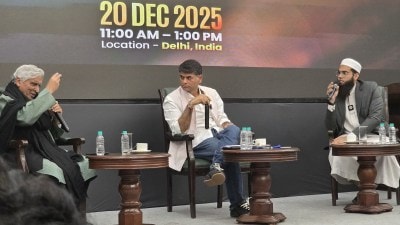Vaccines Injecting Hope’: Science exhibition depicting our Covid journey with an art twist
It's an elaborate look at vaccinology,the science and engineering behind developing vaccines.
 Scott McDonald, Chief Executive, British Council, says, “Our job is to build connections, understanding and trust between people in the UK and across the world. This exhibition is based on science but we have linked art with it, to make the whole content more human. We wanted to show that when you link culture to science, you get better solutions.”
Scott McDonald, Chief Executive, British Council, says, “Our job is to build connections, understanding and trust between people in the UK and across the world. This exhibition is based on science but we have linked art with it, to make the whole content more human. We wanted to show that when you link culture to science, you get better solutions.”
‘Vaccines Injecting Hope’ is an exhibition that takes us through the journey of how the world lived with the arrival of a new virus, COVID-19, what vaccine trials mean and how vaccines were developed across the world.
It’s an elaborate look at vaccinology,the science and engineering behind developing vaccines.
The primary exhibition, inaugurated at the National Science Centre in Delhi on 15, will be open till June 2023, after which it will travel to Nagpur, Mumbai, Bangalore and Kolkata.
A Mobile Science Exhibition, another version of the exhibit, is set to travel to rural areas across northern India.
Developed by National Council of Science Museums (NCSM), Ministry of Culture, Government of India, in collaboration with Science Museum Group, London, the exhibition at the National Science Centre is supported by Wellcome, UK, Indian Council of Medical Research (ICMR) and British Council.
The story begins with British physician and scientist Edward Jenner’s smallpox vaccine from 1796, which arrived in India in a rather royal fashion. It was possibly the only way the British could nudge people to stay safe. The now-famous oil painting of the three Mysore queens, which was up for auction at Sotheby’s recently, shows one of the ladies baring her left arm as a salute to the inoculation. There are animation clips to tell us the story of the royal women in the painting, which was used to promote smallpox vaccination.
Though French microbiologist Louis Pasteur opened the door to vaccine development in the laboratory in the 1880s, it was Scottish scientist June Almedia, a pioneer in microscope imagining, who discovered the human coronavirus in 1964, and, in fact, gave it the name, which in Latin means crown, because of its crown-like halo.
At the inaugural of the exhibition on Tuesday, Rajiv Bahl, director general, ICMR, said, “This exhibition is extremely important because just knowing the science is not enough, science has to reach the people.”
There are multiple sections at the exhibition including ‘Designing a New Vaccine’; ‘Trials, Results and Approvals’; ‘Scaling Up and Mass Production’; ‘Vaccine Rollout’ and ‘Living with COVID’. On display is the hazmat suit of Dr Pragya Yadav, head, Biosafety Level 4 lab, ICMR-NIV (National Institute of Virology), Pune, which brings to memory her testimony of staying zipped in the suit for five to six hours a day, and having to decontaminate and shower thrice before she left the lab.
Then there is a salute to Manish Kumar, the 33-year-old sanitation worker in Delhi’s All India Institute of Medical Sciences (AIIMS), who became the first person in the country to be vaccinated against the coronavirus.
A sculpture titled ‘Through the Lens’ shows a swirling vortex of corona warriors – scientists, researchers, health workers. The artwork has been commissioned by the British Council and created through collaboration between Delhi-based sculptor Sushank Kumar and London-based playwright, Nigel Townsend. A mirror atop the vortex shows the viewer too, and presents a perspective on an individual’s role in the scheme of things.
Scott McDonald, Chief Executive, British Council, says, “Our job is to build connections, understanding and trust between people in the UK and across the world. This exhibition is based on science but we have linked art with it, to make the whole content more human. We wanted to show that when you link culture to science, you get better solutions.”







